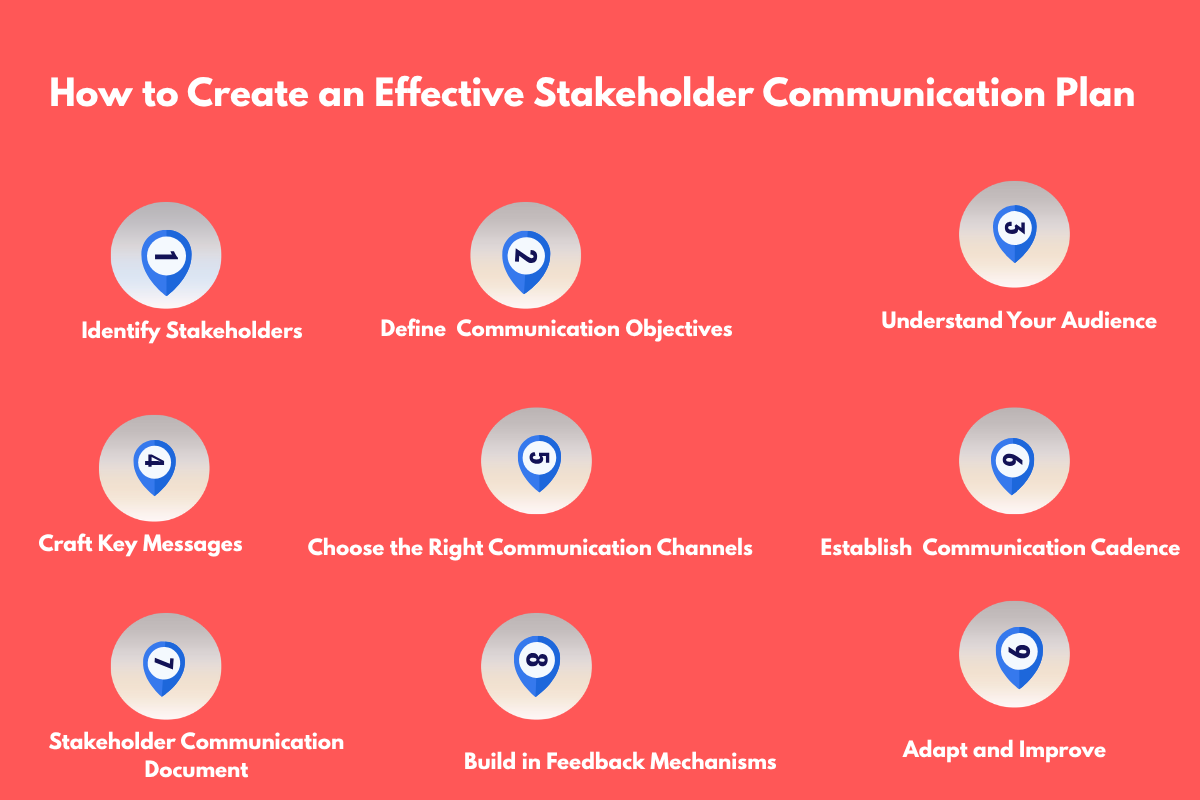

Imagine you’re captaining a ship across stormy waters. You have the best crew, top-tier equipment, and a clear destination. But if no one knows the route, if your navigator isn’t in sync with your engineer, and your deckhands are guessing your next move, even the best ship can sink.
That’s what happens in projects lacking a stakeholder communication plan.
Whether you’re leading a tech rollout, launching a marketing campaign, or managing a construction project, clear and purposeful stakeholder communication is the key to success and avoiding chaos.
In this guide, we’ll walk you through how to create a stakeholder communication plan that builds trust, aligns teams, and keeps your project on course.
<div id ="one">

A stakeholder communication plan is a strategic document that outlines how information will be shared with all individuals or groups affected by a project. It identifies key stakeholders, defines communication goals, selects appropriate channels and methods, and sets a schedule for regular updates.
The plan ensures stakeholders stay informed, engaged, and aligned throughout the project lifecycle.
Key takeaways
<div id ="two">
At its core, a stakeholder communication plan is about clarity and connection. It ensures key stakeholders—anyone who’s impacted by or has influence over a project receive the correct information, at the right time, through the proper channels. This way, they can get the right context and lead successful projects.
Think of communication as the glue that holds your project team, leadership team, and external stakeholders together. Without it, misunderstandings grow, timelines slip, and trust erodes. A well-executed communication plan keeps everyone aligned, informed, and invested in the shared goal. This is why stakeholder management is considered a core competency of strategic leadership, essential for building trust and maintaining an organization's reputation.
<div id ="three">

Before sending a single email or scheduling a meeting, you need to identify who your stakeholders are. Not all stakeholders are equal—and that’s okay. However, failing to recognize the right people early on can lead to blind spots.
Start with a stakeholder analysis. List all individuals, groups, and departments that your specific project will touch. These may include:
Ask:
This process helps you determine who needs to be kept informed, who should be consulted, and who must be deeply engaged.
Just like you wouldn’t start a road trip without a map, don’t start engaging stakeholders without clear objectives. Ask:
Setting goals ensures you stay focused on sharing relevant information and not flooding inboxes with noise.
For example:
Different people need different things. Your leadership team may require high-level updates, while your project team needs detailed technical information. A customer might care only about delivery timelines, not backend complexity.
Segment your stakeholders into groups based on:
Tailoring your messages to each audience helps ensure everyone receives relevant updates in a way they can digest. A key part of this is recognizing the different communication styles in the workplace—whether assertive, aggressive, or passive—as each requires a different approach to ensure your message is heard correctly and to avoid creating a toxic environment.
Next, outline the key messages each stakeholder group needs to hear. These should support your communication objectives and reflect their priorities.
Let’s say you’re rolling out a new software tool:
Each message should be:
Strong messaging supports a shared understanding of project goals, status, and expectations.
This is where many plans fall short. Relying solely on emails or meetings may alienate stakeholders who prefer other formats. Today’s organizations thrive on different channels, from Slack and Teams to dashboards and newsletters.
Determine which communication channels suit your audience:
Ensure the tool or channel you use supports transparency, allows feedback, and works for the person on the receiving end.
Consistency builds trust. Irregular or reactive communication breeds confusion. Set expectations early and stick to a rhythm.
Examples of regular communication might include:
Define who is responsible for sending updates, collecting feedback, and escalating concerns. This structure reduces bottlenecks and fosters better collaboration.
Now, bring it all together. A stakeholder communication plan should be a living document that outlines:
This approach helps you manage expectations, share updates effectively, and build trust across the board.
Here’s a simple example table from a project launch plan:
Communication is not a monologue—it’s a dialogue. If your stakeholders can’t ask questions, raise issues, or provide input, you’re not truly engaging them.
Build feedback loops into your plan:
This not only keeps stakeholders involved, but also provides insight into potential roadblocks early on.
No communication plan is set in stone. Projects shift. Teams evolve. New stakeholders join. Your plan needs to be future-proof.
Review your plan regularly:
Adjust your strategy based on feedback, project shifts, or organizational changes to ensure optimal performance. Keep what works, tweak what doesn’t.
👉 Highrise communication solutions:
<div id ="four">
For project managers, your job is part communicator, part therapist, part air traffic controller. You’re the bridge between different stakeholders—each with their concerns, urgency, and language.
Here’s what excellent communication looks like in action:
Let’s say your organization is releasing a new feature in your mobile app. Here’s how your stakeholder communication plan might look:
A well-thought-out communication plan here avoids panic, confusion, and angry customer tweets.
<div id ="five">
In any project, communication is not just a task—it’s a craft. The ability to connect with the right audience, using the proper channels, at the right time, can turn a messy, chaotic process into a symphony of progress.
And like any craft, communication can be learned, practiced, and mastered. That’s where Highrise comes in.
Highrise isn’t just a project management tool. It’s your collaboration hub, your central source of truth, and your digital war room. With Highrise, you can keep stakeholders informed, coordinate updates across different departments, and deliver key messages with clarity and speed.
It’s built to future-proof your workflow, so no matter how complex your project gets, your communication never breaks down.
Ready to create a stakeholder communication plan that works? Get in touch to get started.